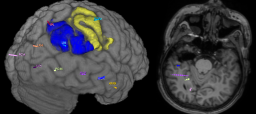Updated computer program helps with epilepsy surgeries at HUS
Keywords:A new version of an image processing program being developed at HUS is about to be completed. The program helps epilepsy surgeons better navigate inside the skull.

Images produced in the program. On the left the cerebral cortex, its areas and placed electrodes. Data: Wang / CC BY 4.0. doi: 10.5281/zenodo.5675459
The radiology department of the HUS Diagnostics Centre is currently developing a new and improved version of the computer tomography and magnetic image editing program for epilepsy patients and the goal is to introduce it for clinical use next year. The program helps with surgeries on epilepsy patients.
Every year, twenty to thirty major epilepsy operations are performed at HUS. The youngest patients are a few months old.
"The better the images we have, the better we can plan the operation routes, i.e. where to go in and what will be removed," says Atte Karppinen, Chief Physician at the HUS Department of Neurosurgery.
Before the actual epilepsy surgery, it is possible to use image processing programs to plan where in the brain the rod-like electrodes can be placed. The plan will be discussed at the epilepsy surgery meeting, and based on the information produced by the image processing program, the plan may still be changed before the electrodes are placed. After this, the brain is scanned from several directions. The measured electrical brain function can then be analysed using an image processing program.
The new version of the program produces 3D visualization of brain surfaces and surface veins faster than the previous version. In general, this significantly speeds up the workflow.
"We have been helping researchers and physicists involved in image processing to develop the program in a direction that makes it more accurate and usable," says Leena Lauronen, Acting Professor of Clinical Neurophysiology and Chief Physician.
Next step is approval from HUS and Fimea registration
The program is a so-called self-manufactured product, i.e. it was originally made at HUS. It would not have been possible to purchase a similar product on the market. Over the years, there have been several improved versions of the program, and its benefits and risks are constantly being assessed. The program and its manufacturing process are examples of how research and product development are combined in HUS Diagnostics and benefit patient care.
HUS's internal approval for the program is currently under review. HUS IT Management has its own certified quality system for self-manufactured products.
The implementation of the program is monitored through reviews, the first of which, a review of the plan's basic data, has already been carried out. Senior Researcher Eero Salli from the HUS Diagnostic Centre, who has been involved in developing the new version, explains that the aim is to complete the final review in March. The different stages of the reviews are documented.
Prior to the actual commissioning, the program will be thoroughly tested with simulated test cases.
When HUS considers that the necessary requirements have been met, the program material will be submitted to the Finnish Medicines Agency Fimea. Fimea will examine the material, possibly ask for further clarification and decide whether it will allow the use of the program.
Once Fimea has registered the new program, it will finally be introduced to patient work, i.e. as help with epilepsy surgeries.
"Our goal is to make it available for clinical use next year," says Salli.
The program is the result of long-term scientific research and product development in the department spanning over ten years.
The transition to the updated software will probably take place gradually.
Once the software has been introduced, the HUS Diagnostics Center will monitor user experiences and the improvement of the program will continue